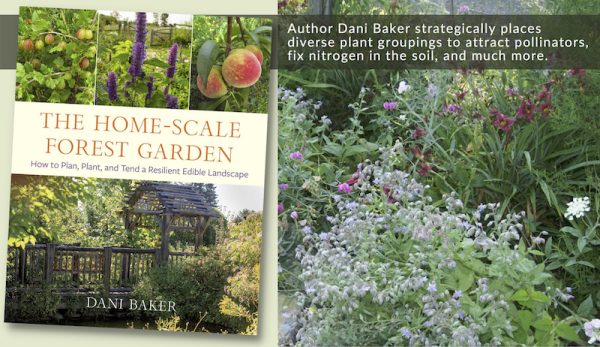
Plant by plant, Dani Baker has been assembling what she calls her “Enchanted Edible Forest” for the last 10 years. “Going way back to my youth, I’ve been very into being ecologically friendly to the earth, and this technique of gardening is kind of the epitome of that,” she says.
Baker is the author of the forthcoming book The Home-Scale Forest Garden: How to Plan, Plant, and Tend a Resilient Edible Landscape. (Chelsea Green Publishing will release The Home-Scale Forest Garden later this month.) Baker’s own permaculture paradise is based in New York state and boasts hundreds of different edible fruits, nuts and flowers.
The Home-Scale Forest Garden shows readers how to grow a greater diversity of plants across the many levels that make up a forest garden. Those levels include the overstory and understory—where fruit, nut and other trees flourish—as well as shrubs, herbaceous plants, groundcovers, vines and fungi.
A Different Mindset
A traditional vegetable garden requires digging, planting, weeding, watering, fertilizing, pest management and other routine tasks year after year. For their part, edible forest gardens require plenty of work, too. Much of it entails painstaking planning and intensive effort around their initial setup.
But after that? As the (largely perennial) plantings in the forest garden become established, there isn’t nearly as much to do. “It’s not like you’re going to eliminate your labor,” Baker says. “But, for a comparable amount of land, there’s going to be a lot less labor going forward than with an annual vegetable planting—and you’re going to have a huge abundance of harvest.”
She continues, “When you landscape with edibles, you also build in other plants that support those edibles. So, you’re going to minimize your need to add any kind of amendments over time. And you’re going to minimize your need to deal with pests and disease, because of the [plant] diversity [you’ve introduced.]”
Such diversity, in turn, attracts many of the natural predators of garden pests. For instance, while certain kinds of fruit trees might attract voracious caterpillars, other nearby plantings may attract some of the very birds and parasitic wasps that feed on those caterpillars.
Read more: Starting a permaculture garden? Invest in a good shovel.
Where to Start
In The Home-Scale Forest Garden, Baker outlines more than 100 food-bearing and multi-purpose plant species. She also suggests beneficial plant groupings to accommodate different needs in the landscape. But before you know which plants and groupings might work best for you, you’ve got to study your landscape.
“Understand the different habitats that may exist there,” Baker suggests. “Take a soil sample, so you know what the qualities are of your soil. And then do your best to match plants with the type of soil and habitat that you have.”
Aim to include lots of plant diversity across each of the forest garden layers—that is the overstory, understory, shrubs, herbaceous plants, groundcovers, vines and fungi.
It’s also a good idea to think ahead about the trajectory of the elements in your existing landscaping. For example, Baker inherited a number of ash trees along a hedgerow on her property. Due to the widespread and destructive emerald ash borer, she suspects those trees eventually will die.
To plan for that likely outcome, Baker explains, “I built my own hedgerow with mostly edibles—like pecan trees—planted just adjacent and parallel to [the ash trees]. That assumes that my [newly planted] trees … will basically take the place of those ash trees once they’ve died.”
Also, rather than immediately remove dead or dying trees, Baker uses them to support vining edibles like grapes.
Read more: Prune and rejuvenate older fruit trees to give them new life.
Patience Pays Off
By their nature, annual vegetable gardens provide plenty to harvest at the end of a single growing season. That’s not necessarily the case with an edible forest garden. If you plant certain kinds of herbs or, say, strawberries, you might be able to harvest some items during your first year.
Still, as the size and diversity of your edible forest garden grows, so will the time you get to spend harvesting. “Starting in my second year, I was harvesting berries,” Baker recalls. “I started getting a little tree fruit even that early.”
Now, after years tending to so many edible perennial plantings, Baker spends much of her time simply harvesting.
How long it may take you to get to this point depends on your access to land and how much time you can devote. Don’t have much time or land? A simple foundation planting of a single tree ringed with a grouping of beneficial plants is a worthwhile start. So are a few well-placed border plants—perfect for screening out the neighbors while feeding and sheltering birds.
“These are all very simple things that people could incorporate,” Baker says. “And they would benefit them as well as the environment.”




